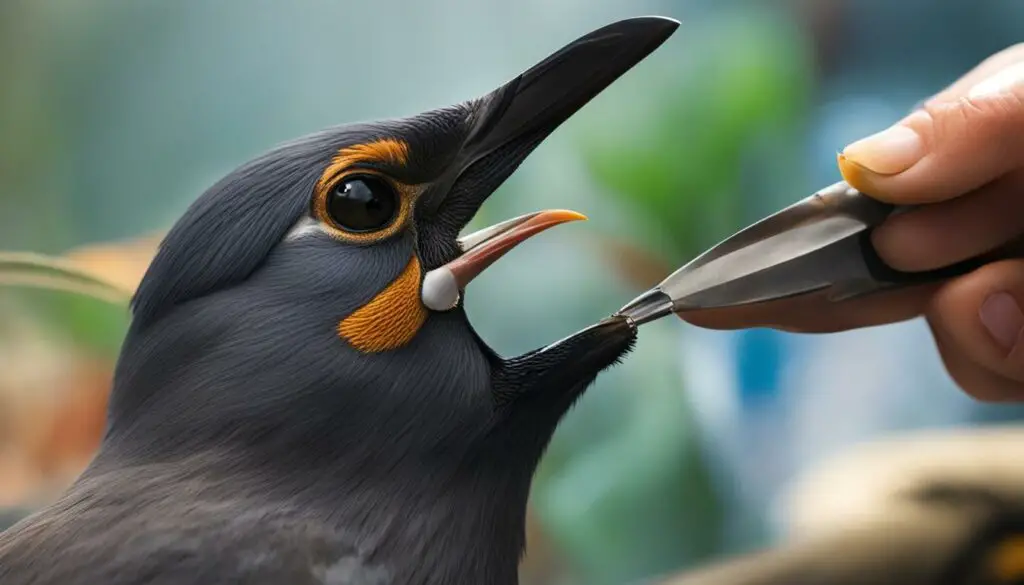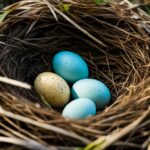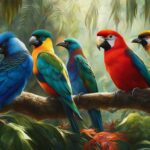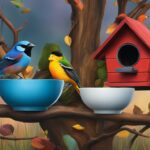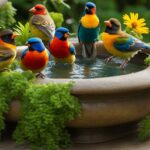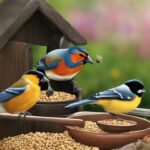As a bird owner, I understand the importance of keeping your feathered friend’s beak healthy and well-maintained. A bird’s beak is not only vital for eating and drinking but also for various activities such as climbing and defending territory. However, an overgrown beak can lead to discomfort, difficulty in eating, and even health problems for your bird.
In this comprehensive guide, I will provide expert tips and techniques for trimming your bird’s beak to ensure their overall well-being. From recognizing the signs of beak overgrowth to preventing it through proper care and diet, I will walk you through every step of the process.
Key Takeaways:
- Regular beak trimming is essential for a bird’s overall health and well-being.
- An overgrown beak can cause discomfort and difficulties in eating and drinking.
- Beak overgrowth can be caused by factors such as an improper diet, infections, injuries, or underlying medical conditions.
- Preventive measures, such as providing chew toys and maintaining a balanced diet, can help avoid beak overgrowth.
- Beak trimming should be done by a professional avian veterinarian using safe and appropriate techniques.
Importance of a Healthy Beak
A healthy beak is vital for the overall well-being of pet birds. It serves various functions, including eating, climbing, and defending territory. A properly maintained beak should be smooth, symmetrical, and have a slight downward curve, facilitating easy opening and closing. On the other hand, an overgrown beak can lead to difficulties in essential activities like eating, playing, and even drinking water.
Recognizing the signs of an overgrown beak is crucial for early intervention. Changes in the shape and length of the beak, discoloration, and peeling are indications of potential overgrowth. Although the initial stages may not significantly impact the bird’s health, advanced stages can result in malnutrition and other health problems.
Preventing beak overgrowth is essential for ensuring the bird’s well-being. Providing appropriate chew toys, such as wooden blocks and mineral blocks, helps naturally wear down the beak. Fresh branches, grooming perches, and hard food like nuts and seeds also encourage beak wearing. Regular monitoring of the bird’s diet and environment is necessary to prevent beak overgrowth and maintain a healthy beak.
Importance of a Healthy Beak
| Advantages of a Healthy Beak | Consequences of Beak Overgrowth |
|---|---|
| Facilitates eating, climbing, and defending territory | Difficulties in essential activities like eating, playing, and drinking water |
| Smooth, symmetrical, and slight downward curve | Changes in shape and length, discoloration, and peeling |
| Prevents malnutrition and other health problems | Potential impact on the bird’s health and well-being |
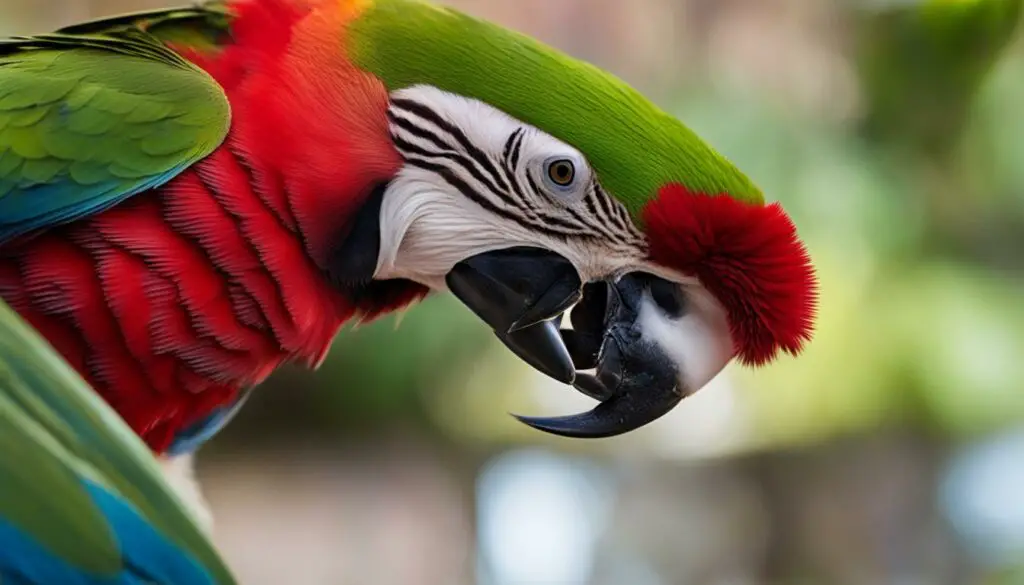
“A healthy beak is essential for a bird’s overall well-being.”
Causes of Beak Overgrowth
Beak overgrowth in birds can be triggered by various factors, including an improper diet, infections, injuries, or even liver disease. A balanced and nutritious diet is essential for maintaining optimal beak health. Birds that are fed a diet lacking in essential nutrients may experience beak overgrowth as a result of inadequate beak usage. Additionally, certain infections or injuries can also contribute to beak overgrowth by causing inflammation or damage to the beak structure.
The liver plays a crucial role in regulating the growth and health of a bird’s beak. Liver disease can disrupt normal beak growth and maintenance, leading to overgrowth. It is important to be aware of these potential causes and take appropriate measures to prevent and address beak overgrowth in pet birds.
| Cause | Description |
|---|---|
| Improper Diet | A diet lacking in essential nutrients can lead to beak overgrowth as birds may not have enough opportunities to use their beaks adequately. |
| Infections | Infections in the beak or mouth can cause inflammation and disrupt normal beak growth and maintenance. |
| Injuries | Trauma to the beak or mouth can result in beak overgrowth as the damaged area may not wear down properly. |
| Liver Disease | Liver dysfunction can affect beak health, leading to overgrowth. The liver plays a vital role in maintaining beak structure and growth. |
Understanding the causes of beak overgrowth is crucial for preventing and addressing this issue in pet birds. By providing a balanced diet, regular veterinary care, and a suitable environment, owners can help ensure their birds have healthy and well-maintained beaks.
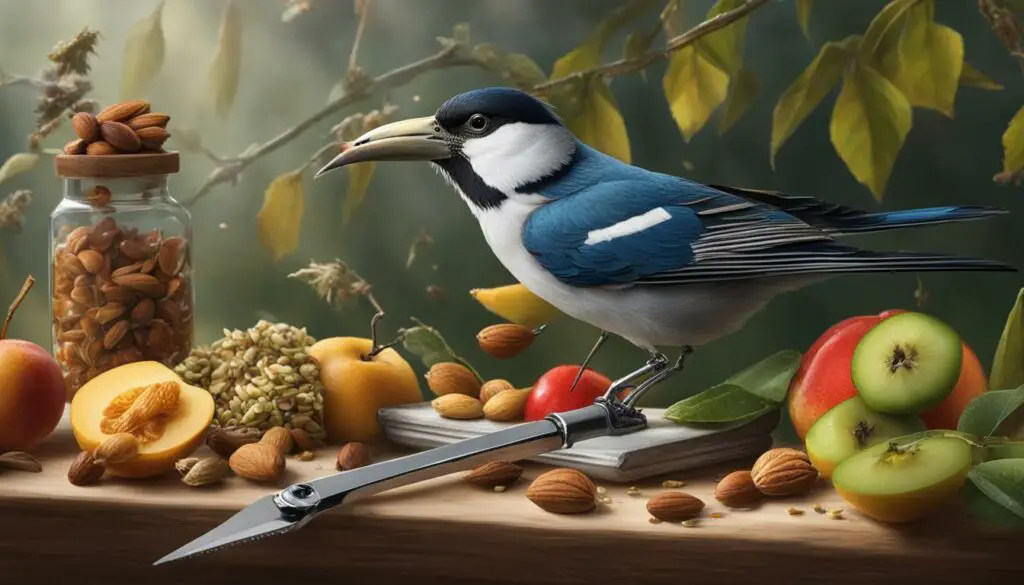
Recognizing an Overgrown Beak
Recognizing the signs of an overgrown beak is crucial for bird owners to ensure the well-being of their feathered friends. While it may be difficult to notice the onset of an overgrown beak, there are specific signs to look out for. Changes in the shape and length of the beak can be an initial indication of overgrowth. Discoloration and peeling of the beak are also common signs that should not be ignored.
In the early stages, an overgrown beak may not significantly affect the bird’s overall health. However, if left untreated, it can lead to malnutrition and other health problems. It is essential to observe any changes in the bird’s beak and seek veterinary care if necessary.
“Changes in the shape and length of the beak can be an initial indication of overgrowth.”
Regular monitoring of the beak and regular check-ups with an avian veterinarian can help owners identify and address any beak abnormalities at an early stage. Taking proactive measures to ensure beak health is crucial for the overall well-being of pet birds.
Common signs of an overgrown beak:
- Changes in the shape and length of the beak
- Discoloration and peeling of the beak
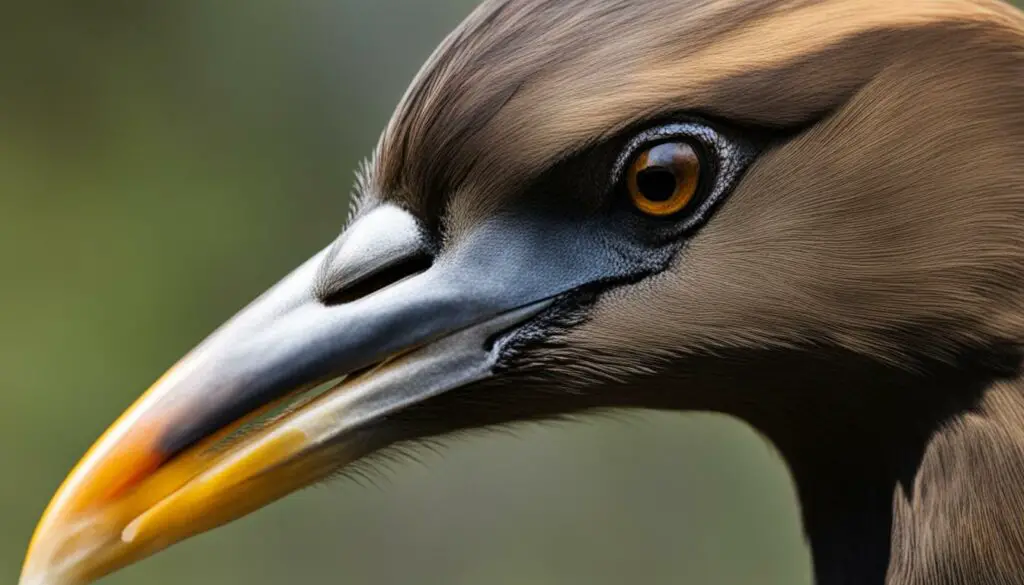
| Signs of Overgrown Beak | Potential Consequences |
|---|---|
| Poor grooming ability | Feathers becoming dirty or matted |
| Difficulty eating or drinking | Weight loss, malnutrition |
| Difficulty climbing or perching | Reduced physical activity, discomfort |
| Discomfort or pain | Behavioral changes, aggression |
Preventing Beak Overgrowth
Ensuring the health and well-being of your bird includes taking preventive measures to avoid beak overgrowth. By providing your feathered friend with the right environment and toys, you can promote natural beak wearing and minimize the need for beak trimming. Here are some effective ways to prevent beak overgrowth:
- Chew toys: Offering wooden blocks, ladders, and mineral blocks as chew toys can help wear down the beak naturally. These toys provide mental stimulation and encourage your bird to engage in beak-related activities, promoting healthy beak maintenance.
- Fresh branches and grooming perches: Adding fresh branches or grooming perches to your bird’s cage allows them to engage in natural beak-wearing behaviors. These provide opportunities for climbing, chewing, and playing, all of which can help keep the beak in good condition.
- Hard food: Including hard foods like nuts and seeds in your bird’s diet can contribute to beak wearing. These foods require more chewing, which can help naturally file down the beak. Ensure that the hard food is appropriate for your bird’s species and size.
Regularly monitoring your bird’s diet and beak health is essential for prevention. If you notice any abnormalities or changes in your bird’s beak, consult an avian veterinarian for further advice and guidance.
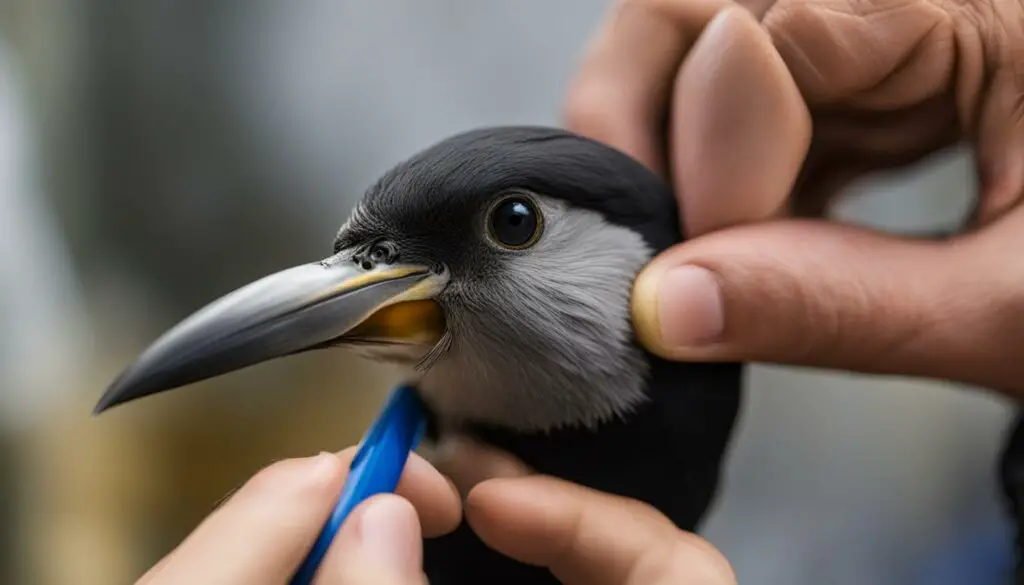
Table: Beak Trimming Tools and Techniques
| Tool/Technique | Description |
|---|---|
| Grinding tool | A specialized tool used by avian veterinarians to gently file down excess beak. It mimics the natural erosion process and is safe when used by a professional. |
| Dremel | A rotary tool that can be used for beak trimming. It should only be used by a trained professional, as improper use can cause injury to the bird. |
| Beak trimming scissors | Designed specifically for trimming a bird’s beak, these scissors have curved blades that allow for precise trimming. They should only be used by experienced individuals, such as avian veterinarians or trained bird groomers. |
| Beak filing board | A flat board with sandpaper or other abrasive material attached. It can be used to file down the beak gently. However, this method requires caution and expertise to prevent injury to the bird. |
It is important to note that beak trimming should always be performed by a professional avian veterinarian. They have the knowledge, experience, and appropriate tools to ensure the process is carried out safely and effectively.
Addressing an Overgrown Beak
If a bird already has an overgrown beak, it is crucial to consult an avian veterinarian for proper care and treatment. The vet will assess the severity of the condition and recommend appropriate measures to address the overgrown beak. Beak trimming should always be done by a professional vet, as it requires specialized tools and techniques to ensure the safety and well-being of the bird.
During the beak trimming process, safety precautions should be followed to minimize any discomfort or stress for the bird. The vet will use tools like a grinding tool or a Dremel to gently file down the excess beak. It is important to use safe and appropriate tools for the bird’s size and species. The vet will trim the beak to the correct length and shape, mimicking the natural erosion process that occurs in the wild.
“Consulting an avian veterinarian is essential to address an overgrown beak. They have the expertise and experience to perform beak trimming safely and effectively.”
Once the beak trimming is done, it is important to provide a quiet and familiar environment for the bird to recover. Avoid excessive cuddling or disturbances that can cause stress. Offer fresh water and nutritious food to support the bird’s overall health and recovery. Monitoring the bird’s behavior and well-being during this period is crucial to ensure a smooth recovery process.
Beak Trimming Safety Precautions
When it comes to beak trimming, it is essential to prioritize the safety and well-being of the bird. Here are some safety precautions to follow:
- Always consult an avian veterinarian for beak trimming to ensure proper care and technique.
- Use specialized tools that are safe and appropriate for the bird’s size and species.
- Minimize stress during the beak trimming process by providing a calm and quiet environment.
- Follow the vet’s instructions for post-trimming care and recovery.
- Monitor the bird’s behavior and well-being during the recovery period.
By following these safety precautions and seeking professional veterinary care, owners can ensure their feathered friends receive the necessary treatment for an overgrown beak and maintain optimal beak health.
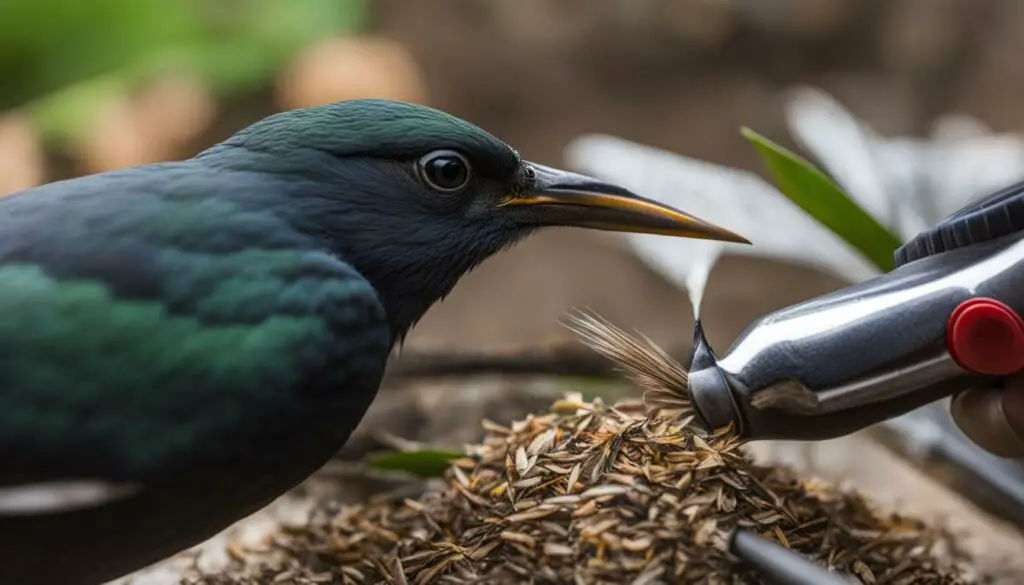
Tips to Support Beak Health
Ensuring the health of a bird’s beak goes beyond just beak trimming. Here are some additional tips to support overall beak health:
- Provide a balanced and nutritious diet: A well-rounded diet is essential for maintaining a healthy beak. Include a mix of pelleted food, fresh vegetables, and occasional fruits to provide essential nutrients and encourage beak health. Avoid fatty and unhealthy foods that can negatively impact the beak.
- Regular check-ups with an avian vet: Regular visits to an avian veterinarian are crucial for monitoring the beak’s condition and addressing any issues early on. A vet can provide guidance on the specific dietary needs of different bird species and offer recommendations for maintaining optimal beak health.
- Maintain a clean and sanitized environment: A clean and sanitary environment helps prevent infections and diseases that can affect a bird’s beak health. Regularly clean and disinfect cages, perches, and toys to ensure a safe and hygienic living environment for your feathered friend.
- Offer appropriate toys and perches: Providing stimulating toys and suitable perches can contribute to beak health by encouraging natural beak wearing. Wooden chew toys, ladders, and mineral blocks are excellent choices that can keep birds entertained while supporting beak health.
By following these tips, bird owners can take proactive measures to support their feathered friend’s beak health and ensure a happy and healthy life for their avian companion.
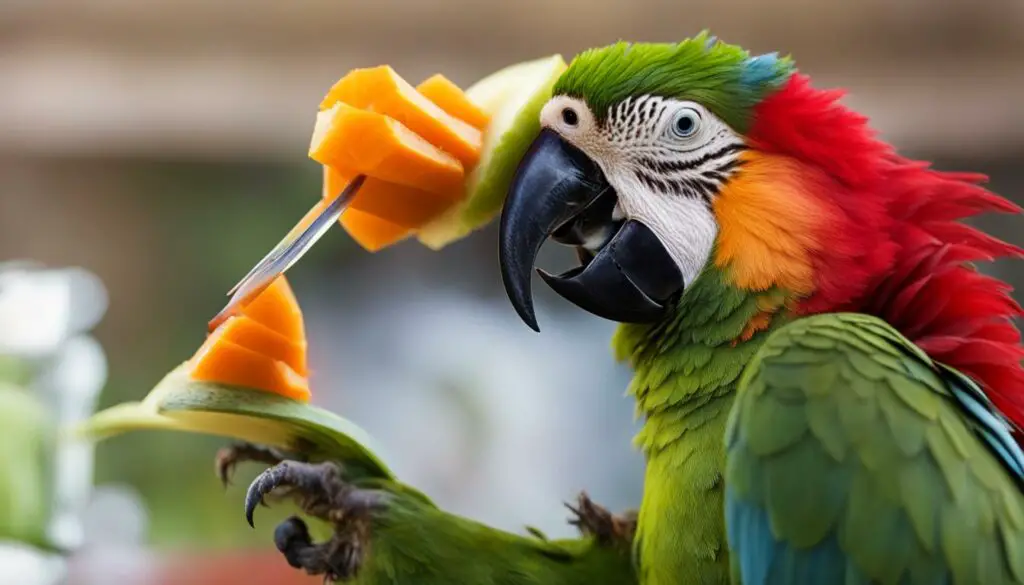
The Role of Diet in Beak Health
A balanced and nutritious diet plays a crucial role in ensuring the overall health and well-being of a bird’s beak. By providing the right types of food, you can promote natural beak wearing and prevent overgrowth.
When it comes to a bird’s diet, it’s important to incorporate foods that require chewing to naturally wear down the beak. Pelleted food, fresh vegetables, and occasional fruits should be the main components of their meals. However, it’s also essential to include hard foods in their diet, such as nuts and seeds, which provide the necessary resistance for beak wearing.
By offering a variety of food textures, you can stimulate the bird to use its beak more actively, naturally maintaining its health. The act of chewing on harder food items helps wear down the beak and prevent overgrowth. It is crucial to avoid relying solely on soft and easy-to-consume pellets, as they do not provide enough resistance for beak wearing.
| Hard Food for Beak Health | Benefits |
|---|---|
| Nuts (e.g., almonds, walnuts) | Provide resistance for beak wearing and are rich in healthy fats and proteins. |
| Seeds (e.g., sunflower seeds, pumpkin seeds) | Require pecking and are a good source of essential nutrients. |
| Whole grains (e.g., corn, barley) | Offer a variety of textures and encourage beak usage. |
| Hard fruits and vegetables (e.g., apples, carrots) | Require biting and provide vital vitamins and minerals. |
Remember to provide a balance in their diet, as overconsumption or lack of variety can lead to other health issues. Consult an avian veterinarian for specific dietary recommendations based on the species of your bird.
Advantages of Chew Toys
When it comes to maintaining the health of a bird’s beak, chew toys are an invaluable tool. These engaging and stimulating toys provide birds with a natural way to wear down their beaks while keeping them entertained. By encouraging healthy chewing behavior, chew toys offer several advantages for beak health.
Easier Beak Maintenance
Chew toys provide a safe and effective way for birds to naturally wear down their beaks. As birds peck and chew on the toys, the abrasive surfaces help to remove excess growth and maintain the beak’s proper length and shape. Regular chewing on these toys can prevent beak overgrowth and ensure that the beak remains in optimal condition.
Physical and Mental Stimulation
Chew toys offer both physical and mental stimulation for birds. The act of chewing helps to exercise the jaw muscles and promote overall beak strength. Additionally, the interactive nature of these toys keeps birds mentally engaged and prevents boredom. Providing a variety of chew toys with different textures, shapes, and materials can keep your bird engaged and entertained for hours.
Prevention of Destructive Behavior
By providing appropriate chew toys, you can help redirect your bird’s natural chewing instincts away from destructive behaviors such as biting furniture, cage bars, or other household objects. Chew toys act as a healthy outlet for birds to satisfy their innate need to chew. This not only protects your furniture and belongings but also promotes a safe and enriching environment for your feathered friend.
In conclusion, incorporating chew toys into your bird’s daily routine is a simple yet effective way to promote beak health. These toys offer several advantages, including easier beak maintenance, physical and mental stimulation, and prevention of destructive behavior. Remember to choose chew toys that are appropriate for your bird’s size and species, and regularly inspect them for signs of wear and tear to ensure your bird’s safety. By providing stimulating and engaging chew toys, you can help keep your bird’s beak healthy and promote their overall well-being.
Beak Trimming Techniques
When it comes to trimming a bird’s beak, it’s essential to seek the expertise of a professional avian veterinarian. They have the knowledge and specialized tools required for safe and effective beak trimming. One common method used by vets is the use of a grinding tool or a Dremel to gently file down the excess beak. It’s crucial to ensure that the tools used are safe and appropriate for the bird’s size and species.
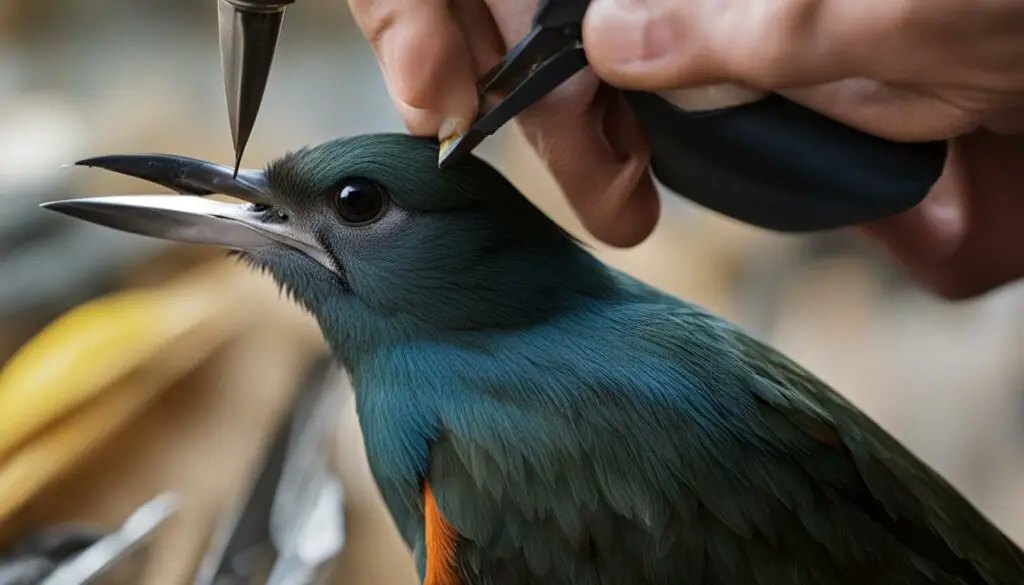
During the beak trimming process, the vet will trim the beak to the correct length and shape, mimicking the natural erosion process. This is done to ensure that the bird’s beak is properly aligned, allowing for normal eating, climbing, and other essential activities. It’s important to note that beak trimming should only be performed by a professional, as improper techniques can cause injury or unnecessary stress to the bird.
Safe Beak Trimming Techniques
Here are some key points to keep in mind regarding safe beak trimming techniques:
- Always consult an avian veterinarian to determine if beak trimming is necessary for your bird.
- Do not attempt to trim the beak yourself, as it requires specialized tools and expertise.
- Ensure that the beak trimming procedure is performed in a calm and controlled environment to minimize stress for the bird.
- Follow the veterinarian’s instructions regarding post-trimming care and any necessary follow-up appointments.
By entrusting the beak trimming process to a professional and following their guidance, bird owners can ensure the health and well-being of their feathered friends.
Recovery and Care After Beak Trimming
After beak trimming, it is essential to provide your feathered friend with a comfortable and familiar environment to aid in their recovery. Avoid excessive cuddling or disturbances during this time, as the bird needs rest and minimal stress. Offering fresh water and nutritious food is crucial to support their healing process. Ensure that their water is clean and easily accessible, and provide a balanced diet that includes a mix of pelleted food, fresh vegetables, and occasional fruits. This will help provide the necessary nutrients for their overall well-being and aid in their beak health.
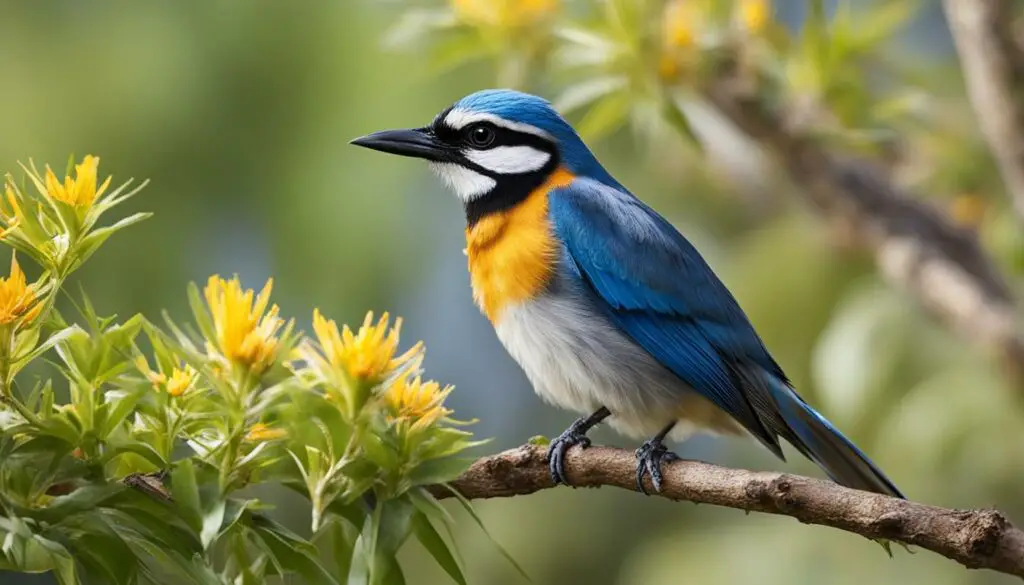
During the recovery period, it is important to closely monitor your bird’s behavior and well-being. Keep an eye out for any signs of discomfort or unusual behavior, as these could indicate complications or the need for further veterinary care. Observation plays a vital role in ensuring their recovery is progressing as expected.
Following the guidance and instructions provided by the avian veterinarian is crucial for a successful recovery. They will provide specific care instructions tailored to your bird’s needs. Ensure that these instructions are followed diligently to support their healing process. If you have any concerns or questions, do not hesitate to reach out to your veterinarian for clarification and guidance.
Reasons to Seek Veterinary Care
If you notice any abnormalities in your bird’s beak, it is crucial to seek veterinary care. An avian veterinarian is trained to diagnose and treat beak-related issues, ensuring the overall health and well-being of your feathered friend. Here are some common reasons to seek veterinary care for your bird’s beak:
Beak Abnormality:
Any change in the shape, size, or appearance of your bird’s beak may indicate an underlying problem. A veterinarian will carefully examine the beak to determine the cause of the abnormality and recommend appropriate treatment.
Excessive Beak Growth:
If your bird’s beak is growing excessively, it can lead to difficulties in eating, drinking, and performing other essential activities. A vet will be able to trim the beak to the correct length and shape, ensuring that your bird can function properly.
Broken Beak:
In the unfortunate event of a broken beak, it is essential to seek immediate veterinary care. A veterinarian will assess the extent of the damage and provide appropriate treatment options to ensure that your bird’s beak heals properly.
Underlying Medical Conditions:
There are various medical conditions that can contribute to beak abnormalities, such as nutritional deficiencies, infections, or liver disease. An avian veterinarian will perform a thorough examination to identify any underlying medical conditions and develop a treatment plan tailored to your bird’s specific needs.
Remember, early detection and treatment of beak-related issues are crucial for your bird’s well-being. By seeking veterinary care, you can ensure that your feathered friend receives the proper care and attention needed to maintain a healthy beak.
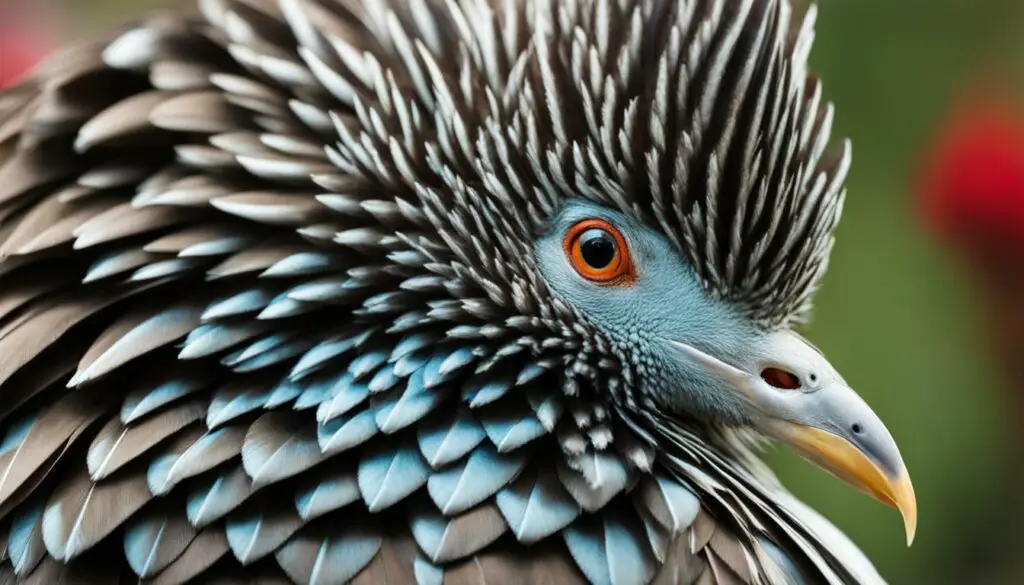
| Common Reasons to Seek Veterinary Care for Bird Beak | Related Conditions |
|---|---|
| Beak Abnormality | Nutritional deficiencies, infections |
| Excessive Beak Growth | Liver disease, improper diet |
| Broken Beak | Injuries, accidents |
| Underlying Medical Conditions | Liver disease, infections, tumors |
Importance of a Balanced Diet
A balanced diet plays a crucial role in maintaining the overall health and well-being of birds, including the health of their beaks. By providing birds with a diverse and nutritious diet, owners can ensure optimal beak health and prevent beak overgrowth. A balanced diet should consist of a mix of pelleted food, fresh vegetables, and occasional fruits, all tailored to the specific dietary needs of different bird species.
Table: Nutritional Components of a Balanced Bird Diet
| Nutrient | Sources |
|---|---|
| Protein | Pelleted food, lean meats, legumes |
| Vitamins and Minerals | Fresh vegetables, fruits, fortified bird food |
| Healthy Fats | Nuts, seeds, and avocado (in moderation) |
| Fiber | Fresh vegetables, whole grains |
Incorporating hard foods like nuts and seeds in a bird’s diet can also encourage beak wearing. These foods require chewing, which helps naturally wear down the beak and prevent overgrowth. Additionally, offering a variety of chew toys, such as wooden blocks and mineral blocks, can provide birds with mental stimulation and physical exercise while contributing to beak health.
By maintaining a balanced diet and providing appropriate toys and perches, bird owners can ensure their feathered friends have healthy and well-maintained beaks, promoting overall health and preventing potential problems associated with beak overgrowth.
Conclusion
In conclusion, maintaining the health of your bird’s beak is of utmost importance. By following this comprehensive bird beak trimming guide, you can ensure the well-being of your feathered friend. Remember, a healthy beak is crucial for their overall quality of life.
Regularly monitor your bird’s beak for any signs of overgrowth or abnormalities. Take preventive measures to avoid beak overgrowth by providing chew toys, fresh branches, grooming perches, and a balanced diet. If your bird already has an overgrown beak, it is essential to consult an avian veterinarian for professional beak trimming.
Support your bird’s beak health by offering a well-rounded diet with a mix of pelleted food, fresh vegetables, and occasional fruits. Regular check-ups with a vet, maintaining a clean environment, and providing appropriate toys can further contribute to their beak health.
Remember, your avian veterinarian is your ally in ensuring the well-being of your bird’s beak. Don’t hesitate to seek their care and guidance for any beak abnormalities or concerns. With proper care, attention, and healthy habits, you can keep your bird’s beak in optimal condition, enhancing their overall quality of life.
FAQ
What are the signs of an overgrown beak?
Signs of an overgrown beak include changes in shape and length, discoloration, and peeling.
How can I prevent beak overgrowth?
You can prevent beak overgrowth by providing chew toys, fresh branches, grooming perches, and hard food for beak wearing.
Can I trim my bird’s beak myself?
No, beak trimming should always be done by a professional avian veterinarian.
How often should beak trimming be done?
The frequency of beak trimming depends on the individual bird and its rate of beak growth, but it is typically needed every few months.
What should I do after my bird has its beak trimmed?
After beak trimming, provide a quiet and familiar environment for your bird to recover. Offer fresh water and nutritious food, and follow any instructions given by the vet.
How can I maintain my bird’s beak health?
Maintaining a balanced diet, regular check-ups with an avian vet, and providing appropriate toys and perches can help keep your bird’s beak healthy.
Can an overgrown beak be a sign of an underlying medical condition?
Yes, an overgrown beak can be caused by conditions such as infections, injuries, or liver disease. It is important to seek veterinary care to address the underlying cause.
What should I feed my bird to promote beak health?
A balanced diet that includes pelleted food, fresh vegetables, and occasional fruits can contribute to beak health.
How do chew toys help with beak health?
Chew toys provide stimulation for birds and encourage beak wearing, which helps prevent overgrown beaks.
What tools are used for beak trimming?
Beak trimming should be done by a professional vet who uses specialized tools like a grinding tool or a Dremel to file down the excess beak.
When should I seek veterinary care for my bird’s beak abnormalities?
It is important to seek veterinary care if your bird’s beak has changed shape, grown excessively, or has broken off. A vet will diagnose the underlying causes and provide appropriate treatment.
How does diet affect beak health?
Providing a balanced and nutritious diet that includes foods requiring chewing can help maintain beak health.
Source Links
- https://www.thesprucepets.com/trimming-a-birds-beak-390672
- https://www.birdcagesnow.com/blogs/bird-blog/how-to-prevent-overgrown-beaks-in-pet-parrots
- https://www.wikihow.com/Trim-a-Bird’s-Beak

